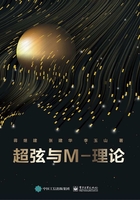
6.5 延伸的世界片超对称
玻色弦世界片作用量的推广对于包括N=1的世界片上的超对称,已经为我们提供了10-维中具有时空对称性的弦理论。鉴于这一成功,人们自然想知道从扩展世界片对称性的作用量开始,能够实现什么样的理论追求。对于弦理论,实际上我们必须要求超共形对称性,以便使引入的所有类引力场实现局域规范对称性,从而退出经典的运动方程。实现超共形对称性的可能性是非常小的。仅存在弦理论拥有共形对称性的两种可能性:一种是当N=2时,弦世界片上存在所需要的共形对称性;另一种是N=4,在这一扇区并没有给出具有物理意义的弦理论。
6.5.1 N=2理论
N=1超共形对称群已经用无限代数描述过,这种代数在左-动扇区和右-动扇区包含一个关于玻色边界条件的OSp(1,2)子代数。推广到N=2,以OSp(2,2)替代这个子代数。这意味着玻色生成子包括SO(2)≈U(1),除了Sp(2) ≈U(1,1)。费米生成子组成一个SO(2)对偶,或者一个U(1)的复表达。具有N=2超对称的库仑规范作用量包含一个玻色坐标![]() ,除
,除![]() 之外,还有一个费米坐标
之外,还有一个费米坐标![]() (i=1,2)的SO(2)对偶物:
(i=1,2)的SO(2)对偶物:

(6.5.1)
其明显具有SO(2)对称性,该对称性使![]() 互相转换而抛弃了无效的X和Y。超对称荷也是一个SO(2)对偶物,正如人们从变换公式看到的:
互相转换而抛弃了无效的X和Y。超对称荷也是一个SO(2)对偶物,正如人们从变换公式看到的:

(6.5.2)
式中,![]() 是具有
是具有![]() 的反对称符号。该作用量必须通过适当约束以通常方式增补。
的反对称符号。该作用量必须通过适当约束以通常方式增补。
指标μ=0,1,2,…,D-1表示时空方向,![]() 可看作对时空中嵌入的世界片的描述,而
可看作对时空中嵌入的世界片的描述,而![]() 本质上以同样的方式进入数学。S的洛伦兹对称性恰是SO(D-1,1),所以确定Y并不描述通常意义上的额外维度。它可能是理论上至关重要的微妙之处,但目前还说不清楚。
本质上以同样的方式进入数学。S的洛伦兹对称性恰是SO(D-1,1),所以确定Y并不描述通常意义上的额外维度。它可能是理论上至关重要的微妙之处,但目前还说不清楚。
现在进行数学分析。式(6.5.1)能够更简洁地写成复坐标:

(6.5.3)
的形式,后者恰是D=2时的狄拉克旋量。现在有

(6.5.4)
式中,已经去掉了时空指标μ。根据狄拉克超-对称参数![]() ,整体N=2超对称变换是
,整体N=2超对称变换是

(6.5.5)
下一步,我们想用再参量化不变量的形式重新表达作用量。这需要超引力坐标的多重态,由![]() ,一个狄拉克引力子
,一个狄拉克引力子![]() 和一个要求SO(2)对称性局域化的矢量规范场
和一个要求SO(2)对称性局域化的矢量规范场![]() 组成。结果是
组成。结果是

(6.5.6)
事实上,![]() 唯一出现在它被显式显示的一项中。其运动方程为
唯一出现在它被显式显示的一项中。其运动方程为![]() ,表达了SO(2)流的消失,它补充了遵从
,表达了SO(2)流的消失,它补充了遵从![]() 和
和![]() 场方程的条件
场方程的条件![]() 。
。
除局域再参量化不变量、洛伦兹不变量和超-对称性之外,式(6.5.5)具有大量另外的对称性。存在通常的外尔标度对称性:

(6.5.7)
以及N=2时的超-共形对称性:

(6.5.8)
也存在由![]() 场:
场:

(6.5.9)
规范的局域SO(2)对称性。这一对称性也具有手征配对物:

(6.5.10)
式中,![]() ,也是局域对称的。这两组局域对称意味着
,也是局域对称的。这两组局域对称意味着![]() 的分量自对偶和反自对偶,即
的分量自对偶和反自对偶,即![]() ,像左-动和右-动的局域SO(2)规范群那种规范场一样作用。
,像左-动和右-动的局域SO(2)规范群那种规范场一样作用。
现在考虑约束的超-维拉宿代数,这种约束产生于弦理论的量子化,我们专注于玻色开弦扇区。![]() 坐标的模型是复振子
坐标的模型是复振子![]() ,满足:
,满足:

(6.5.11)
类似地,对玻色子边界条件,狄拉克场![]() 给出了复-半整数模的振子
给出了复-半整数模的振子![]() ,这类振子具有性质:
,这类振子具有性质:

(6.5.12)
根据上述诸式,能量-动张量的傅里叶模是

(6.5.13)
超-流J的模是

(6.5.14)
而SO(2)流的模是

(6.5.15)
![]() 算符的代数是
算符的代数是

(6.5.16)
式(6.5.15)是一个关于SO(2)群的阿贝尔卡茨-穆迪代数,它们常常被称为仿射李代数。这一类型的无穷维代数扮演着一个十分重要的角色。SO(2)流具有共形维数J=1,所以:

(6.5.17)
超流的SO(2)荷是±1,于是

(6.5.18)

(6.5.19)
维拉宿代数有N=1情况下的两倍异常,因为玻色子和费米坐标数翻了一倍,

(6.5.20)
没有双荷运算符,故

(6.5.21)
代数中最有趣的括号或许是

(6.5.22)
如同先前的弦理论,我们需要物态满足约束方程:

(6.5.23)

(6.5.24)

(6.5.25)

(6.5.26)
最后的方程意味着,具有非零U(1)荷的所有态是非物理的。这可解释为一种U(1)约束原理。现在我们通过寻找零-规范物态来寻找a和D的首选值。
考虑形式如![]() 的态,有
的态,有

(6.5.27)

(6.5.28)
这个态是零模物态,如果它被![]() 所湮灭,则
所湮灭,则

(6.5.29)
如果![]() ,则式(6.5.28)为0。于是首先选择a=0,这表明基态是无质量标量。于是谱线没有超光子,甚至在任何可能的GSO截断之前的情况都在考虑之列。
,则式(6.5.28)为0。于是首先选择a=0,这表明基态是无质量标量。于是谱线没有超光子,甚至在任何可能的GSO截断之前的情况都在考虑之列。
现在我们构建零-模态,它决定临界维数。考虑:

(6.5.30)
已知:

(6.5.31)

(6.5.32)
利用展开的超-维拉宿代数,直截了当地导出下列各式:

(6.5.33)

(6.5.34)

(6.5.35)
因此,结论是,对于![]() ,D=2,态
,D=2,态![]() 是零模物态。于是,D=2正是理论的临界维数。容易证明,当D>2时存在幽灵态。
是零模物态。于是,D=2正是理论的临界维数。容易证明,当D>2时存在幽灵态。
D=2是临界维数的结论意味着在光锥规范中完全不存在横向振子。因此出现了无质量标量基态仅是理论中的传播自由度这一情况,至少在这一扇区。然而,理论的量子化中的微妙之处已被指出,这一陈述可能需要修正。如果理论确实具有单一的标量模,那么这一模式必然取决于某个局域量子场理论,但是这一理论尚未确定。费米场也没有确定下来,如果有的话,应该伴随这个“标量”出现。
总之,N=2超弦结构的延伸给出了一个高度对称的量子理论和一个有趣的超-维拉宿代数的推广。它似乎不能给出弦理论的一般解释,因为临界维数是D=2,并且在这个维度上不存在弦的横向激发。或许它以其他的尚未知晓的某种方式进入物理学。
6.5.2 N=4理论
N=4理论有一个更丰富的数学结构,以及一个更糟糕的物理结果。局域SO(2)群被局域SU(2)群取代,并且存在4个局域超对称和超共形对称。物理坐标由4个![]() 型变量和4个
型变量和4个![]() 型马约拉纳旋量组成。前者是SU(2)的单线态,后者是一对SU(2)的双重态。
型马约拉纳旋量组成。前者是SU(2)的单线态,后者是一对SU(2)的双重态。
作用量原理和对称变换可以像以前一样写下来。然而,我们将这些跳过去而直奔规范代数。维拉宿代数异常再一次倍增:

(6.5.36)
局域SU(2)代数在卡茨-穆迪代数中的结果是

(6.5.37)
有4个![]() 算符,其变换如同SU(2)的一对倍增。于是有
算符,其变换如同SU(2)的一对倍增。于是有

(6.5.38)
这里,按照2×2泡利度规![]() 有
有

(6.5.39)
我们十分感兴趣的反对易泊松括号是

(6.5.40)
算符恒等式能够从关于振子α和b的显式表达中推导出来。所以所有雅可比恒等式确定得到满足。
这一方案导致负临界维数D=-2,对超弦理论似乎没有合理的解释。